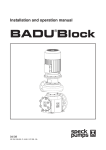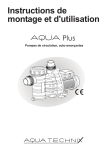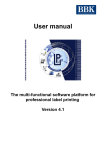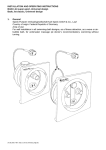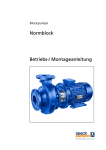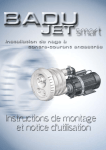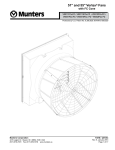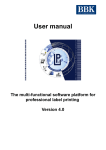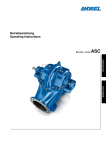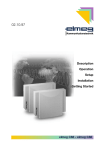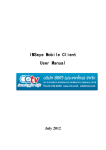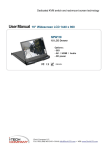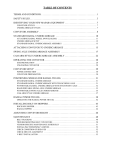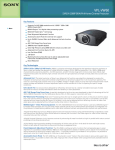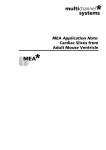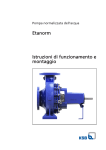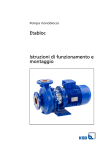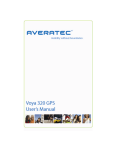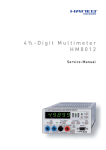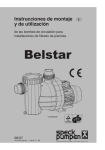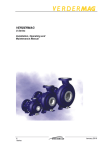Download "user manual"
Transcript
Installation and operation manual Norm Block Pump 08/09 VG 766.1320.050 2' 08/09 1. General information GB CAUTION Speck Pumpen Verkaufsgesellschaft GmbH, Neunkirchen am Sand Series norm block pumps Country of origin: Federal Republic of Germany 2.1 Symbols for safety instructions used in the operation manual Safety instructions for the prevention of danger to persons are indicated by the safety symbol denoting a general hazard area according to ISO 7000 – 04324: This Speck pump has been developed and constructed with greatest care corresponding to state-ofthe-art technology and is subject to permanent quality checks. This operation manual introduces the user to the pump and its intended uses. Please pay attention to the instructions for operating the pump safely, appropriately and efficiently in order to ensure its reliability and longevity, as well as to avoid danger. The operation manual makes no mention of local regulations! The user alone is responsible for making sure these are adhered to – also by assembly personnel. When operating this unit, do not exceed the values – as put down in the technical documentation – with regard to the pumped fluid, flow rate, motor speed, density, pressure and temperature as well as motor performance or other specifications in the operation manual or the contractual documentation. When in doubt, please contact manufacturer. The nameplate identifies the series / size, the most important operating data and the identification number. Please always quote this number on any inquiries, reorders and especially spare part orders. Should you require any additional information or advice, or should any damage occur, please contact the closest Speck customer care service. To caution against electrical hazards, the safety symbol according to IC 417 – 5036 is used: Safety instructions for the prevention of danger to the machine and its functions are emphasized by the word ACHTUNG Symbols which are affixed directly to the machine, as e.g. - an arrow denoting the direction of rotation - sign for fluid connections must by all means be paid attention to and kept fully legible. 2.2 Qualification and training of staff 1.1 Certificates of conformity, test symbols and related matters Staff responsible for operating, service, inspection and installation must be fully qualified for these tasks. The CE-symbol is attached to the pump. The certificate of conformity is part of the appendix of this operation manual. The details of staff responsibility, competence and surveillance are to be regulated by the user. If the staff lacks the required skills, they must be trained and instructed. The user may charge the manufacturer with doing so. Furthermore the manufacturer must make sure that the staff fully understands the contents of the operation manual. 1.2 Noise level The noise level mostly depends on the lines connected to the pump. The noise level stated is only valid for the pump on its own. The noise level data are included in the Technical Data Sheet in the appendix. If the noise level is not specified, it is lower than 75 dBA. 2. Ignoring safety instructions can be dangerous as well to persons as to the environment and the machine. Ignoring the safety instructions will void any warranties. Safety In detail, ignoring the safety instructions may cause: This operation manual contains fundamental instructions concerning installation, operation and servicing. Therefore, the mechanic, the staff in charge of the machine as well as the user must study this operation manual before installation and start-up. Keep the operation manual permanently available at the installation site. - failure of important functions of the machine / unit Not only all general safety instructions in this chapter must be observed, but also the special safety instructions in the other chapters. 2 2.3 Dangers of ignoring safety instructions - failure of prescribed methods of servicing and maintenance - danger to persons caused by electrical, mechanical and chemical impact - danger to the environment caused by leakage of hazardous substances - damage to institutions and buildings 2.4 Safety-conscious operating The safety-instructions specified in the operation manual, national directions for accident prevention as well as the user’s internal directives for operational safety must be observed. 2.5 Safety instructions for the user / operator transport straps. Do not hang the pump by its free shaft extension or the ring terminal of the motor! The ring bolts on the motor are only to be used for transporting the motor, not the whole pump! A pump slipping through a transport strap can injure persons and damage objects! - Dangerously hot or cold machine parts must be protected from accidental contact by the user. - Do not remove equipment which protects the machine against accidental contact from moving parts (e.g. a clutch), when the machine is in operation. - Leakages (e.g. at the shaft seal) of dangerous pumping materials (e.g. explosive, toxic, hot) must be discharged without causing danger to persons or the environment. Observe legal requirements! - Eliminate any possibility of danger caused by electrical power! For details see e.g. regulations of VDE and the local utilities. 2.6 Safety instructions for maintenance, inspection and installation The user must make sure that authorized and qualified expert staff only is put in charge of maintenance, inspection and installation. These experts must have thoroughly studied the operation manual before beginning their work. The pump must be at ambient temperature, depressurized and empty. On principle, the pump must stand still to be worked on. By all means follow the shutting down process as described in the operation manual. Pumps or pump units conveying materials which are dangerous to health must necessarily be decontaminated. Immediately after work on the machine is finished, all safety and protection equipment must be reinstalled on the machine and reactivated. VD 60.017 If the pump is transported without the motor, shaft 210 must be fastened: 1. Press the cover panels 68-3 lightly together and remove them through the windows of the lantern bracket 341. 2. Pull the lock washer 931 into the well nut and secure it by means of hexagon head screws 901.3. Before restarting the machine, observe all instructions in chapter “Initial start-up” in the operation manual. 2.7 Unauthorized modification or production of spare parts Changing or modifying the machine is only permitted after consulting the manufacturer. The safety of the machine can only be guaranteed if original spare parts and accessories which are authorized by the manufacturer are used. The manufacturer does not assume responsibility for the consequences which result from the use of components from other suppliers. 2.8 Unauthorized operation The operational safety of the delivered pump can only be guaranteed, if the pump is appropriately used according to the specifications in the subsequent chapters of the operation manual. The limits stated in the data sheet must not be exceeded under any circumstances. 3. Transport, temporary storage 3.1 Transportation The unit must be transported appropriately. During transportation, the pump must be firmly fixed in a horizontal position to keep it from slipping through the VD 60.016 3 3.2 Temporary storage (Internal storage) rust-proofing In case of temporary storage only the low-alloyed components in contact with liquids (e.g. cast iron JL 1040) need to be rust-proofed. Commercially available preserving substances can be used for this. For application / removal follow the specific instructions of the manufacturer. The procedure is described in Section 6.3. The unit / pump ought to be stored in a dry room, preferable with constant humidity. For outside storage it is necessary for unit and packing case to be protected by a watertight cover in order to avoid contact with moisture. CAUTION Protect stored goods against moisture, dirt, vermin and unauthorized access! All openings of the assembled components of the unit are closed and must only be opened if required during assembly. For rust-proofing all blank parts and surfaces are oiled, respectively greased (silicon-free oil and grease). 4. Description of product and accessories 4.1 General description Norm block centrifugal pumps are non self-priming, mono-stage, spiral casing pumps in horizontal block design. They achieve a high circulation, while taking little space because of their compact design. The back-pullout design allows the drive unit to be replaced without disconnecting the pipe-work for ease of assembly or disassembly. 4.2 Constructional design Construction: Spiral pumps, mono-stage with power rating according to EN 733. Shaft equipped with a replaceable shaft sleeve in the area of the shaft seal. Spiral casing and impeller equipped with replaceable split rings. Flanged pump and motor are close-coupled to form a block unit with norm motor. The pump shaft is rigidly connected with the motor shaft. Shaft seal: Mechanical seal according to EN 12 756. Drive: Electrical motor. Protection against accidental contact: Cover plates on the lantern brackets in accordance with EN 294. 4.3 Table of materials: Version 05 11 12 Casing parts Tin bronze CC480K-GS Cast iron EN-JL 1040 Cast iron EN-JL 1040 Impeller Tin bronze CC480K-GS Cast iron EN-JL 1040 Tin bronze CC-480K-GS Mechanical seal Carbon/SiC/EPDM On request SiC/SiC/HNBR Carbon/SiC/EPDM On request SiC/SiC/HNBR Carbon/SiC/EPDM On request SiC/SiC/HNBR Split rings CC495-GS CC495-GS CC495-GS Pump shaft 1.4571 X6 Cr Ni Mo Ti 17-12-2 1.4571 X6 Cr Ni Mo Ti 17-12-2 1.4571 X6 Cr Ni Mo Ti 17-12-2 Shaft protection sleeve 1.4571 X6 Cr Ni Mo Ti 17-12-2 1.4571 X6 Cr Ni Mo Ti 17-12-2 1.4571 X6 Cr Ni Mo Ti 17-12-2 Drive lantern Cast iron EN-JL 1040 Cast iron EN-JL 1040 Cast iron EN-JL 1040 VD 60.002 5. 5.1 Installation Checks before installation The structural layout must be prepared in accordance with the dimension and assembly drawings. The concrete foundations should be of sufficient strength (min. class X0) according to DIN 1045. The concrete foundation must have set before the unit is set up on it. The surface of the foundation must be horizontal and even. 5.1.1 Ground, foundations, wall It must be possible to set up the pump, respectively the unit safely and stress-free on the foundations. Distortions can cause an untimely wearing of the pump. Make sure that no vibrations are passed on through the foundations. 5.1.2 Space requirements for operation and maintenance When installing the unit, make sure that it is possible to exchange parts of or the complete unit. Heavy units must be equipped with appropriate facilities for fastening and supporting lifting tools and other devices. Access routes for delivery and removal must be provided. 5.2 Installation of the unit During installation the unit must be leveled with the help of the water level on the pressure connection. Spiral casing and pressure cover will approximately assume the temperature of the pumped liquid. Pressure cover and lantern bracket must not be insulated. Appropriate measures have to be taken to avoid burns. 5.3 Connecting the pipes CAUTION The pump must not be used as an anchor point for pipes under any circumstances. The pipe system must not exert any forces and momentums on the pump (e.g. by distortion or heat expansion). 4 When laying the suction line, make sure it ascends towards the pump. The supply line must descend towards the pump. The pipes must be supported directly in front of the pump and have stress-free connections. adequate distance from the drill holes for the measurement. The set-up for the flow rate measurement must follow the regulations of the manufacturer of the measuring instrument. The nominal diameter of short pipes must at least equal the diameter of the pump connections. The most economical diameter of long pipes must be determined individually. Adaptor pieces for larger nominal diameters should be designed with an enlargement angle of approx. 8° in order to avoid increased pressure loss. The advisability of non-return valves and shut-off valves depends on the type of unit and of the pump. Suitable measures must be taken to compensate for the thermal expansion of the pipes in order not to strain the pump beyond the pipe forces and momentums permitted. Exceeding the pipe forces may cause the appearance of leaky spots where the pumping material oozes out. Hot pumping materials may cause danger of life! The flange covers on the suction and pressure connection must be removed before installing the piping. Before starting the unit, the tanks, pipes and connections must be thoroughly cleaned, rinsed and air purged. Weld beads, scaling and other impurities often only dissolve after a long time. 5.3.1 Supplementary connections See installation drawing or pipe layout diagram for dimensions and position of the supplementary connection for the pump. 5.3.2 Dimensioning of the pipes In order to avoid friction loss, the flow rate must be max. 1.5m/s in suction or supply lines, max. 2.5 m/s in pressure lines. The rules of piping construction must be observed concerning the piping layouts and the liquid quantities in order to prevent the pump from sucking air. Dry running of the pump can cause considerable damage to pump and seals. 5.3.3 Measuring point diagram The pressure of centrifugal pumps is measured following ISO 2548 “standardized experimental arrangements” (sketch 1, page 48). Make sure, however, that the flow rate in the measuring pipe does not considerably exceed the values stated in 5.3.2. If the flow rate exceeds those values, the pressure / suction flanges must be equipped with adaptor pieces. (sketch 2, page 48) To ensure a reliable measurement, follow the instructions in chapter 5.3.2 and the corresponding sketch with regard to the flow rate values when measuring pressure. Pipe elbows, valves, adaptor pieces etc. can falsify the measuring results and must therefore be at an 5 Sketch 1 Sketch 2 VD 60.018 5.4 Electrical connection The electrical connection may only be carried out by a qualified electrician. Observe DIN VDE regulations 0100 and explosive atmosphere regulations 0165. Compare the voltage at hand with the data on the motor rating plate and select the appropriate connection. Observe the technical connection provisions of the local utility when connecting the unit. The use of a motor protection device is strongly recommended. 5.4.1 Motor connection The direction of rotation of the three-phase AC motor is strictly clockwise in accordance with DIN VDE 0530 part 8 (looking on the motor stub shaft). The direction of rotation of the pump is anti-clockwise (looking on the suction flange). To convert the motor to the direction of rotation of the pump, it should be connected following fig. 5.41 or fig. 5.4-2. 6 connection Δ (low voltage) Fig. 5.4-1Connection diagram for three-phase AC motors, connection Δ Connection Y (high voltage) - the direction of rotation has been checked - all supplementary connections have been made. 6.1.1 Shaft seal Shaft seal (see 7.4.4 and 7.5.2) 6.1.2 Filling and checking the pump The pump and its supply line must be vented and filled with pumping fluid before start-up. The shutoff valve in the suction line must be completely open. CAUTION VD 25.226 Fig. 5.4-2 Connection diagram for three-phase AC motors, connection Y If required, connect PTC thermistor according to DIN 44081 / 44082 to downstream triggering unit following fig. 5.4-3. Running he pump dry will cause increased wear and must be avoided! 6.1.3 Final check It must be possible to turn the shaft by hand with ease. Check if the connections are working properly. 6.1.4 Protection against accidental contact According to accident prevention regulations the pump may only be operated if it is protected against accidental contact. 6.1.5 Switching on Only switch the unit on with the shutoff valve on the pressure side switched on! When full speed is reached, open it slowly and adjust it to the operating point. CAUTION Fig. 5.4-3 Connection diagram for PTC thermistor 5.4.2 Timer relay setting Make sure for three-phase AC motors with star-delta circuit that there is a speedy switchover between star and delta. Long intervals will cause damage to the pump. For star-delta circuits set the timer relay to <3 s. 5.4.3 Checking the direction of rotation The motor’s direction of rotation must correspond to the direction of the arrow on the spiral casing (as viewed from the motor side in clockwise direction). Check by switching the motor on and then immediately off again. The direction of rotation must only be checked with the pump and the pipes primed, as important components can be destroyed if the pump runs dry. In case of wrong direction of rotation, reverse any two phases L1, L2 or L3 of the supply line in the terminal box of the motor. 6. 6.1 Start-up / switching off Initial start-up CAUTION Before starting the pump ensure that: - the unit is electrically connected and all prescribed protective measures are taken. - the pump is filled with pumping material After reaching operating temperature and / or in case of leakages, tighten the hexagonal nut 920.2 or .3 or .4 after switching the unit off. 6.1.6 Switching off Close the shutoff valve in the pressure line. If a non-return valve is installed in the pressure line, the shut-off valve can remain open as long as there is back pressure. When switching the pump off, the shutoff valve in the supply line must not be closed. Switch off the motor. Make sure that it coasts quietly to a halt. Depending on the unit the pump - after the heating source has been switched off – should coast for long enough to reduce the temperature of the pumped fluid enough to prevent the heat from accumulating inside the pump. For a long standstill close the shutoff valve in the supply line. Close the supplementary connections. In order to protect the pump against frost and in case of a long standstill, the pump should be emptied. 6.2 Operating range limits 6.2.1 Temperature of the pumped fluid CAUTION Do not operate the pump at temperatures higher than those specified on the data sheet or on the rating plate. 6.2.2 Switching frequency In order to avoid a notable increase of the temperature inside the motor and an excessive strain on the pump, motor, seals and bearings, the following num- 7 ber of switching cycles per hour (h) must not be exceeded. Norm block pumps 15 switching cycles per hour 6.2.3 Minimum volume If the type of unit includes the possibility of operating against a closed shutoff valve on the discharge side, provide a minimum pumping volume at t –30 bis + 70 °C ≈ 15 % von Qopt. t >30 bis + 140 °C ≈ 25 % von Qopt. 6.2.4 Density of the pumped fluid The power consumption of the pump changes in proportion to the density of the pumped fluid. In order to avoid overloading of motor and pump, the density must be consistent with the order data. 6.3 Switching off / storage / rust-proofing Every pump is carefully assembled before it leaves the factory. If start-up is to be delayed for any length of time after delivery, we recommend to store the pump as described below. 6.3.1 Storing new pumps - New pumps are packed ready for storing in the factory. Protection lasts for approx. 12 months, when appropriately stored inside. - Store the pump in a dry place. 6.3.2 Procedures for an extended non-operational period 1. The pump remains installed and has its functions checked periodically In order to ensure a constant operational readiness and to prevent deposits on the inside of the pump, a test run of the pump must be carried out (for approx. 5 min.) every 1 -3 months during a long standstill. Only run the pump, if it is filled with an adequate amount of water. 2. Pump is dismantled and stored Before storing the pump it must be checked according to chapters 7.1 and 7.4. Then proceed with rust-proofing: - Spray the inside of the pump with preservative agent, especially the area around the impeller gap. Spray the preservative agent through the pressure and suction connection. It is advisable to close the connections (e.g. by means of plastic caps or similar). 6.4 Restart after storage Before restarting the pump, the checks and maintenance works must be carried out according to 7.1 and 7.2. For restarting the pump, also observe the instructions in chapter “Initial start-up” (6.1) and “Operational range limits” (6.2). Immediately after finishing these activities, all safety and protection equipment must be reinstalled and reactivated. 7. 7.1 8 Maintenance / Inspection General instructions The user has to make sure that maintenance, inspection and installation is carried out by authorized and qualified expert staff after thoroughly studying the operation manual. Drawing up a maintenance schedule will help avoid expensive repairs at minimal maintenance costs and ensure failure-free and reliable operation of the pump. Principally the machine must only be worked on when disconnected from electricity. The pump unit must be protected against accidental switch-on in order to avoid danger of life. Pumps which convey fluids which are dangerous to health must be decontaminated. When draining the fluid make sure to avoid any danger for persons and the environment. Observe legal requirements to avoid danger of life! 7.2 Maintenance / Inspection 7.2.1 Monitoring CAUTION The pump ought to run smoothly and vibration-free at all times. The pump must not run dry! Do not run the pump against a closed shut-off valve in order to avoid heating up of the pumped fluid. Max. permissible ambient temperature 40°C. Storage temperature may exceed room temperature by 50°C, but by no means rise beyond 90°C (measured on the outside of the motor casing). For the required minimum volume see 6.2.3. Make sure the shut-off valve in the supply line is not closed when the pump is in operation. A properly working mechanical seal must have no, or only a small amount of visible leakage losses (vaporous). It is maintenance-free. Installed reserve pumps must be operated at least once a week by fast on and off-switching to ensure constant operational readiness. Watch the functioning of the supplementary connections. 7.2.2 Lubrication and lubricants 7.2.2.1 Lubrication The roller bearings in the IEC motor are lubricated with grease. Intervals, quality and amount are specified subsequently. 7.2.2.2 Quality of grease / grease change The bearings are filled with high-quality, lithium-soap grease. Under normal operating conditions the filling will last for 15,000 operating hours or for 2 years. Under bad operating conditions, e.g. high ambient temperature, high humidity, dusty air, aggressive industrial atmosphere etc., the bearings should be checked earlier and, if necessary, be cleaned. For this purpose use grease containing lithium soap. It should be free of resin and acid, must not become brittle and should provide rust protection. The grease should have a penetration value between 2 and 3, corresponding to a walk penetration of 220 to 295 mm/10. The drop point ought not to be below 175°C. The cavities in the bearings may only be approx. half filled with grease. If necessary, the bearings can be filled with greases containing other soap bases. As greases containing different soap bases may not be mixed, the cavities must first be cleaned. The lubrication intervals may have to be adjusted to the requirements of these greases. CAUTION General legal requirements regarding disposal have to be observed. Sealed bearings with permanent lubrication (2 RSbearing or 2 Z bearing) cannot be washed out and refilled with grease. Therefore the bearings must be exchanged. Motors from manufactured size 180 are equipped with re-lubrication devices and flange lubrication nipples in accordance with DIN 3404. 7.3 Emptying / disposal If the pump was used for conveying fluids dangerous to health, make sure not to endanger persons or the environment when emptying the pump. Observe legal requirements! If necessary, wear protective clothing and a protective mask! 7.4 Demontage Before starting the disassembly, make sure that the pump cannot accidentally be switched on. The shut-off valves in the pressure / suction line must be closed. The pump must be at ambient temperature, depressurized and empty. Disassembly and assembly may only be carried out as described on the exploded drawing. 7.4.1 Basic instructions Repairs and maintenance of the pump must only be put to the charge of specially trained staff using original spare parts (see 2.7). Observe safety precautions according to instructions in chapter 7.1. When working on the motor, observe the instructions and regulations of the manufacturer. Disassembly and assembly must be carried out following the sequence on the explosion drawings on pages 56 to 63. In case of damage, please contact the customer service facility closest to you. See the attached list of addresses for our customer service locations. 7.4.2 Preparations for disassembly 1 Cut off electricity. 2 Disassembly of the complete unit 2.1 Disconnect the motor leads 2.2 Disconnect the pressure / suction connections from the pipes 2.3 Depending on the manufactured size of the pump / motor, unfasten the mounting bolts of the motor base from the foundation. 2.4 Pull the complete unit out of the piping. 3 During disassembly the pump casing remains in the piping. 3.1 Disconnect motor. 3.2 Unscrew hexagonal nut 920.2 / .3 / .4. 3.3 Depending on the manufactured size of the pump / motor, unfasten the mounting bolts of the motor base from the foundation. 3.4 Pull the complete installation set and the motor out of the pump casing. 4. Pump remains in the piping; disassembly of the motor: 4.1 Disconnect the motor. 4.2 Press the cover panels 68-3 slightly together and remove them through the windows of the lantern bracket 341. 4.3 Unscrew the hexagonal nut 920.5.. 4.4 Unscrew the hexagonal nut 901.3. 4.5 Place both locking plates 931 on the shaft key seat 210. 4.6 Tighten hexagonal bolts 901.3. 4.7 Detach the motor. After a long period of operation individual parts may possibly be hard to detach from the shaft. In this case use one of the well-known rust solvents or, if possible, a suitable extractor tool. Do not use force under any circumstances! 7.4.3 Pump Disassembly of the pump must be carried out as described on the explosion drawing on pages 56 to 63. 7.4.4 Mechanical seal In order to exchange the mechanical seal, it is necessary to disassemble the pump. After removing the impeller 230 pull the mechanical seal 433 from the shaft by hand. Before assembly clean the shaft sleeve and remove any scores and scratches with emery cloth, if necessary. If scoring or pitting is still visible, replace the shaft sleeve, clean the counter-ring seat. 7.5 Reassembly 7.5.1 Pump When assembling the pump, observe the machinebuilding regulations in force. Before assembly brush the mating areas of the individual parts with graphite or a similar substance. This applies equally to bolt connections. Check O-rings for damage and replace where necessary. As a general rule, gaskets must be replaced. Always replace them with seals of the same thickness. Gaskets made from asbestos-free materials or graphite must be assembled without the use of lubricants on principle. Assembly aids should be avoided if at all possible. However, if necessary, use a commercially available contact adhesive (e.g. Pattex) or HY-LOMAR or Epple 33 sealant. Apply a thin film of the sealant at selected points. Cyanoacrylate adhesive (instant glue) must not be used. If the sealing area between the impeller neck and the split ring is worn, the split ring 502.1 and, if existing, 502.2 must be renewed. Play in the gap: new 0.3 mm in Ø max. permissible extension to 0.9 mm in Ø 9 The assembly is carried out following the sequence of disassembly in reversed order. The correct sequence of the individual parts must be maintained. 7.5.2 Mechanical seal Installation is carried out following the sequence of removal in reversed order. The basic rules for assembling a mechanical seal are as follows: Maximum care, extreme cleanliness. Only remove the contact protection from the slide faces immediately before starting the assembly. Avoid damaging the sealing surfaces and the O-rings. Clean the shaft and the counter-ring seat in the pressure cover and carefully remove deposits. During installation of the seal, the friction forces of the shaft sleeve 523 can be reduced by wetting its surface with water. CAUTION Elastomers made of EP-rubber must never come into contact with oil or grease. Use water as fit-up aid. Always press in the counter-ring into the pressurecover 163 by hand or finger. Apply pressure evenly. 7.5.3 Assembly of the motor When mounting the motor, follow the reversed sequence of dismantling it. During installation and before start-up, make sure to pull the locking plates 931 out of the shaft keyseat and secure them with the hexagonal bolts 901.3. CAUTION When mounting the shaft 210 onto the motor stub shaft, ensure that the keyseat on the motor shaft end and the slot of shaft 210 are congruent and positioned opposite to the slot of clamping ring 515. 10 7.5.4 Screw tightening torques VW 60.007 Schnitt A-A Fig. 7.5-2 Bolt tightening points for pump unit Item A B C D VW 60.006 Fig. 7.5-1 Shaft assembly Part No. Part name 210 515 901.3 914.1 931 Shaft Clamping ring Hexgonal bolt Allen screw Locking plate 1) Thread size [mm] M 10 M 12 M 12 x 1,5 M 20 x 1,5 M 30 x 1,5 M8 M 10 M 12 M 16 M6 M8 Tightening torque 1) MA [Nm] 40 55 25 85 140 15 30 45 80 10 25 Refers to non-lubricated threads A= Bolt connections on the casing parts B= Impeller nut C= Bolt connections lantern bracket / motor D= Bolt clamp ring / stub shaft 11 7.6 Ordering spare parts Any order of spare parts must include the following information as specified on the rating plate, e.g.: Type norm block pumps 50/160 Serial number: Model: Year of manufacture: 2002 or the spiral house casing, e.g.: 50/160 7.6.1 Recommended stockkeeping of spare parts for two years of continuous operation according to DIN 24 296 Part No. Part name Quantity of pumps (including reserve pumps) 2 3 4 5 6 and 7 8 and 9 10 and more Quantity of spare parts 210 Shaft 1 1 1 2 2 2 20 % 230 Impeller (including split ring 502.2) 1 1 1 2 2 2 20 % 230.1/.2 Impeller (set) 1 1 1 2 2 2 20 % 400.1/.2 Gaskets (set) 4 6 8 8 9 12 150 % 412.3 O-ring 2 3 4 4 4 5 100 % 433 Mechanical seal 1 1 2 2 2 3 25 % 502.1 Split ring 2 2 2 3 3 4 50 % 523 Shaft sleeve 2 2 2 3 3 4 50 % 12 Faults / causes and remedies Flow rate of the pump too low Driving engine overloaded Protective motor switch de-energized Increased storing temperature Pump is leaking Shaft seal is leaking excessively Pump is running erratically Unacceptable temperature increase in the pump 8. l Cause Pump operates against too much pressure Back pressure too high Pump or piping not completely deaerated or not completely filled Supply line or impeller blocked l Formation of air pocket in piping l l l l l l l l l l l l l l l l l Wrong direction of rotation Wear on internal parts Pump’s back pressure is lower than stated in the purchase order Higher density or higher viscosity of the pumped fluid than stated in the purchase order Defective seal l l Shaft seal worn Scores or roughness on the shaft sleeve l Pump runs erratically l l Pump is twisted l Increased axial stroke 2) l Too little, too much or unsuitable lubricant Running on 2 phases l l l Suction height too large/NPSHunit (supply too low) l Rotor out of balance l l l Bearing damaged Flow rate too low Protective motor switch incorrectly adjusted Transport safety devices have not been removed from the keyseat 1) 2) Remedy 1) Set new operating point Check the unit for impurities Deaerate or top up Remove deposits in the pump or the piping Change piping Insert an air-bleed valve Correct liquid level Open shut-off valve in the supply line If the resistance in the supply line is too heavy, change supply line. Check the installed filters/suction openings Reverse two phases of the power supply Exchange worn parts Adjust operating point 2) Exchange the seal between the spiral casing and pressure cover Renew shaft seal Renew the shaft sleeve Renew the shaft seal Correct suctions conditions Increase the pressure on the suction connection Check pipe connections and pump fixings; if necessary reduce space between pipe clips; piping on vibration-isolating material Clean the impeller relief bores Replace the split ring Increase, reduce or replace lubricant Replace blown fuse Check the electrical connections Clean impeller Re-balance impeller Exchange Increase minimum flow rate Check adjustment Excange protective motor switch Remove The pump must be depressurized before correcting faults on parts which are under pressure Enquiry required 13 14 411.5 903.2 903.1 411.5 903.2 903.1 102 902.3 902.4 920.1 502.1 940 550.1 930 210 230 523 515 914.1 502.2 433 920.4 68-3 400.2 902.5 341 400.1 163 920.5 931 901.3 801 9. Related documents Spare parts drawing Norm block pumps Model with clamped pressure cover Z. Nr. VW60.003 Spare parts list Norm block pumps Model with clamped pressure cover valid for: Norm Block Pumps 32/125, 32/160, 40/125, 40/160, 50/125, 50/160, 65/125, 65/160, 80/160, 80/200, 100/160, 100/200, 125/200, 150/200 VDMA-No. Description 102 Spiral casing 3) 163 Pressure 183 cover Motor base 2) 210 Shaft 230 Impeller 341 Lantern bracket 400.1 Gasket 400.2 411.5 Gasket 1) Sealing ring 433 Mechanical seal 502.1 Split ring 502.2 Split ring 515 Clamping ring 523 Shaft sleeve 550.1 Disc 68-3 Cover plate 801 Flanged motor 901.3 Hexagonal bolt 902.3 Stud bolt 902.4 2) Stud bolt 902.5 Stud bolt 903.1 903.2 Locking screw 1) Locking screw 914.1 Allen bolt 920.1 Hexagonal nut 920.4 Hexagonal nut 920.5 Hexagonal nut 930 Spring washer 931 Locking plate 940 Shaft key 1) Only for norm block pumps material combination 07 2) Only for norm block pumps material combinations 11, 12 up to motor manufactured size 112 = 4 kW from motor manufactured size 132 = 5.5 kW with motor base (not contained in explosion drawing) 3) Spiral casing with base only for material combinations 05, 07 When ordering spare parts, please include type of pump, serial number, and article number of the parts! VW60.003-01 15 16 411.5 903.2 903.1 411.5 903.2 903.1 102 902.1 920.1 502.1 940 550.1 930 210 230 523 515 914.1 502.2 433 920.4 920.3 68-3 400.2 902.5 341 400.1 163 920.5 920.2 902.2 902.4 931 901.3 801 Spare parts drawing Norm block pumps Model with screwed on pressure cover Z. Nr. VW60.002 Spare parts list Norm block pumps Model with screwed on pressure cover valid for: Norm block pumps 32/200, 32/250, 40/200, 40/250, 40/315, 50/200, 50/250, 50/315, 65/200, 65/250, 65/315, 80/250, 80/315, 100/250, 100/315, 125/250, 150/250 VDMA-No. 102 3) 163 Pressure 183 2) 210 230 341 400.1 400.2 411.5 1) 433 502.1 502.2 515 523 550.1 68-3 801 901.3 902.1 902.2 902.4 2) 902.5 903.1 903.2 1) 914.1 920.1 920.2 920.3 920.4 920.5 930 931 940 Description Spiral casing cover Motor base Shaft Impeller Lantern bracket Gasket Gasket Sealing ring Mechanical seal Split ring Split ring Clamping ring Shaft sleeve Disc Cover plate Flanged motor Hexagonal bolt Stud bolt Stud bolt Stud bolte Stud bolt Locking screw Locking screw Allan screw Hexagonal nut Hexagonal nut Hexagonal nut Hexagonal nut Hexagonal nut Spring washer Locking plate Shaft key 1) Only for norm block pumps Material combination 07 2) Only for norm block pumps Material combinations 11, 12 up to motor manufactured size 112 = 4 kW from Motor manufactured size 132 = 5.5 kW with motor base (not contained in explosion drawing) 3) Spiral casing with base only for norm block pumps material combinations 05, 07 When ordering spare parts, please include type of pump, serial number and article number of the parts! VW60.002-01 17 18 902.5 515 920.4 411.5 903.2 903.1 411.5 903.2 903.1 102 902.3 920.1 502.1 930 940 210 230 502.2 914.1 523 433 400.2 68-3 341 400.1 163 931 920.5 901.3 801 Spare parts drawing Norm block pumps Model with clamped pressure cover (motor manufactured size 200 = 30 kW to 225 = 45 kW) Z. Nr. VW60.005 Spare parts list Norm block pumps Model with clamped pressure cover (motor manufactured size 200 = 30 kW to 225 = 45 kW) valid for: Norm block pumps 80/160, 80/200, 100/160, 100/200, 125/315, 150/315 VDMA-No. Description 102 Spiral casing 163 Pressure 1) cover 210 Shaft 230 Impeller 341 Lantern bracket 400.1 Gasket 400.2 Gasket 411.5 1) Sealing ring 433 Mechanical seal 502.1 Split ring 502.2 Split ring 515 Clamping ring 523 Shaft sleeve 68-3 Cover plate 801 Flanged motor 901.3 Hexagonal bolt 902.3 Stud bolt 902.5 Stud bolt 903.1 Locking screw 903.2 1) Locking screw 914.1 Allan screw 920.1 Hexagonal nut 920.4 Hexagonal nut 920.5 Hexagonal nut 930 Spring washer 931 Locking plate 940 Shaft key Only for norm block pumps material combination 07 When ordering spare parts, please include type of pump, serial number und the article number of the parts! VW60.005-01 19 920.5 902.5 920.3 515 411.5 903.2 903.1 411.5 903.2 903.1 102 902.1 920.1 502.1 930 940 210 230 502.2 914.1 523 433 400.2 68-3 341 400.1 163 902.2 920.2 931 901.3 801 Spare parts drawing Norm block pumps Model with screwed-on pressure cover (motor manufactured size 200 = 30 kW to 225 = 45 kW) Z. Nr. VW60.004 20 Spare parts list Norm block pumps Model with screwed-on pressure cover (motor manufactured size 200 = 30 kW to 225 = 45 kW) valid for: Norm block pumps 50/200, 50/250, 65/200, 65/250, 80/250, 80/315, 80/400, 100/315, 100/400, 125/250, 125/400, 150/250 VDMA-No. 102) 163 Pressure 210 230 341 400.1 400.2 411.5 1) 433 502.1 502.2 515 523 68-3 801 901.3 902.1 902.2 902.5 903.1 903.2 1) 914.1 920.1 920.2 920.3 920.5 930 931 940 1) Description Spiral casing cover Shaft Impeller Lantern bracket Gasket Gasket Sealing ring Mechanical seal Split ring Split ring Clamping ring Shaft sleeve Cover plate Flanged motor Hexagonal bolt Stud bolt Stud bolt Stud bolt Locking screw Locking screw Allan screw Hexagonal nut Hexagonal nut Hexagonal nut Hexagonal nut Spring washer Locking plate Shaft key Only for norm block pumps material combination 07 When ordering spare parts, please include type of pump, serial number and article number of the part! VW60.004-01 21 V E R K A U F S G E S E L L S C H A F T GmbH EG-Konformitätserklärung Déclaration CE de conformité / EC declaration of conformity / Dichiarazione CE di conformità / EG-verklaring van overeenstemming / EU-yhtäpitävyysilmoitus / Declaracion de conformidad im Sinne der EG-Maschinenrichtlinie 89/392/EWG, Anhang II A conformément à la directive CE relative aux machines 89/392/CEE , Annex II A / as defined by machinery directive 89/392/EEC Annexe II A / ai sensi della direttiva CE 89/392 relativa a macchinari, Appendice II A / inzake richtlijn van de raad betreffende machines 89/392/EEG, bijlage II A / määriteltynä konedirektiivin 89/392/EEC liite ll mukaan / segun se define en la directriz para maquinas de la CE 89/392/CEE, Anexo II A Hiermit erklären wir, dass das Pumpenaggregat Par la présente, nous déclarons que le groupe moteur-pompe / Herewith we declare that the pump unit / Si dichiara, che la pompa / hiermede verklaren wij, dat het pompaggregaat / Täten ilmoitamme, että pumppulaite / Por la presente declaramos que la unidad de bomba: Type: Type: / Type: / Tipo: / Type: / Malli: / Tipo: Auftrags- Nr: N° d´ ordre: / Order no.: / Numero d´ordine: / Opdracht-Nr.: / Tilausnumero: / N° pedido: Baureihe Série: / Series: / Serie: / Serie: / Mallisarja:/ Serie: Normblock Pumpen folgenden einschlägigen Bestimmungen entspricht: correspond aux dispositions pertinentes suivantes: / complies with the following provisions applying to it: / è conforme alle s pertinenti: / in de door ons geleverde uitvoering voldoet aan de eisen van de in het vervolg genoemde bepalingen: / cumple las disposiciones pertinentes: / vastaa seuraavia asiaan kuuluvia määräyksiä: equenti disposizioni siguientes EG-Maschinenrichtlinie 98/37/EG CE-Directives européennes 98/37/CE: / EC-machinery directive 98/37/EC: / CE-Direttiva Macchine 98/37/CE: / EG-Machinerichtlijn EU-konedirektiivi 98/37/EU: / directiva europea de maquinaria 98/37 CE: 98/37/EG: / EMV-Richtlinie 2004/108 EC Directives CE sur la compatibilité électromagnétique 89/336/CEE modifiées par 93/68/CEE: / EMC-Machinery directive 89/336/EEC, in succession 93/68/EEC / Direttiva di compatibilità elettromagnetica 89/336/CEE mod.93/68/CEE: / Richtlijn 89/336/EEG, gewijzigd door 93/68/ EEG: / Sähkömagneettinen yhteensopivuus (EMC) konedirektiivi 89/336/EEC, jota on muutettu direktiivillä 93/68/EEC: / directiva 89/336/CEE: / EG-Niederspannungsrichtlinie 2006/95/EG CE-Directives basse tension 2006/95/CE / EC-Low voltage directive 2006/95/EC / CEE-Direttiva di bassa tensione 2006/95/CE / EG- laagspanningsrichtlijn 2006/95/EG / EU-pienjännitedirektiivi 2006/95/EU / directiva de baja tension 2006/95/CE EG-Richtlinie 2002/96/EG (WEEE) Directive 2002/96/CE (DEEE) / Directive 2002/96/EC (WEEE) / Direttiva UE 2002/96/EG (WEEE) / EG-Richtlijn 2002/96/EG (WEEE) / E U-direktiivi 2002/96/EC (WEEE) / CE-Directiva 2002/96/EG (tratamiento de residuos de componentes de aparatos eléctricos y electrónicos en desuso) EG-Richtlinie 2002/95/EG (RoHS) Directive 2002/95/CE (RoHS) / Directive 2002/95/EC (RoHS) / Direttiva UE 2002/95/EG (RoHS) / EG-Richtlijn 2002/95/EG (RoHS) / E U-direktiivi 2002/95/EC (RoHS) / CE-Directiva 2002/95/EG (limitación de utilización de determinados productos peligrosos en aparatos eléctricos y electrónicos) Angewendete harmonisierte Normen, insbesondere EN 60335-1 EN 60335-2 – Teil 41 D-91233 Neunkirchen a. Sand, Ort Fait à Place Localita Plaats Paikka Lugar 01.08.2009 Datum le date data Datum Päiväys Fecha i.V. F. Eisele (Technischer Leiter) (Directeur Technique) (Technical director) (Direttore tecnico) (Technisch directeur) (Teknillinen johtaja) (Director tecnico) Adresse / Adresse / Address / Indirizzo / Adres / Osoite / Direccion: Hauptstraße 1-3 D-91233 Neunkirchen a. Sand ppa. A. Herger (Produktmanager) (Chef de produits) (Product manager) (Responsabile prodotti) (Productmanager) (Tuotepäällikkö) (Jefe de producción) VG 766.1320.050 2' 08/ 09 D/F/GB - BA Normes harmonisées utilisées, notamment: / Applied harmonized standard in particular / Norme armonizzate applicate in particola re / Gebruikte geharmoniseerde normen, in het bijzondere / Käytettyjä harmonisoituja normeja, erityisesti / Normas armonizadas aplicadas, especialmente






















